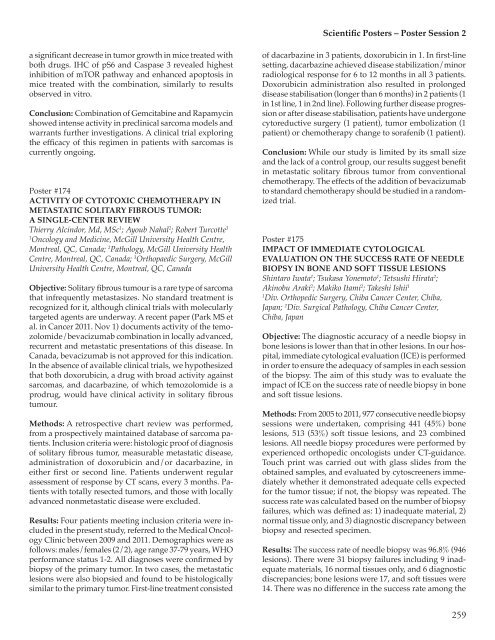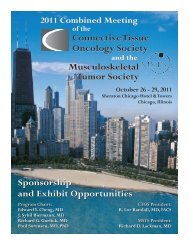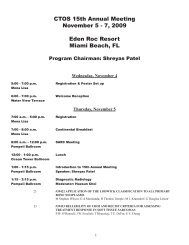207 Poster Session 2 - Connective Tissue Oncology Society
207 Poster Session 2 - Connective Tissue Oncology Society
207 Poster Session 2 - Connective Tissue Oncology Society
You also want an ePaper? Increase the reach of your titles
YUMPU automatically turns print PDFs into web optimized ePapers that Google loves.
Scientific <strong>Poster</strong>s – <strong>Poster</strong> <strong>Session</strong> 2a significant decrease in tumor growth in mice treated withboth drugs. IHC of pS6 and Caspase 3 revealed highestinhibition of mTOR pathway and enhanced apoptosis inmice treated with the combination, similarly to resultsobserved in vitro.Conclusion: Combination of Gemcitabine and Rapamycinshowed intense activity in preclinical sarcoma models andwarrants further investigations. A clinical trial exploringthe efficacy of this regimen in patients with sarcomas iscurrently ongoing.<strong>Poster</strong> #174ACTIVITY OF CYTOTOXIC CHEMOTHERAPY INMETASTATIC SOLITARY FIBROUS TUMOR:A SINGLE-CENTER REVIEWThierry Alcindor, Md, MSc 1 ; Ayoub Nahal 2 ; Robert Turcotte 31<strong>Oncology</strong> and Medicine, McGill University Health Centre,Montreal, QC, Canada; 2 Pathology, McGill University HealthCentre, Montreal, QC, Canada; 3 Orthopaedic Surgery, McGillUniversity Health Centre, Montreal, QC, CanadaObjective: Solitary fibrous tumour is a rare type of sarcomathat infrequently metastasizes. No standard treatment isrecognized for it, although clinical trials with molecularlytargeted agents are underway. A recent paper (Park MS etal. in Cancer 2011. Nov 1) documents activity of the temozolomide/bevacizumabcombination in locally advanced,recurrent and metastatic presentations of this disease. InCanada, bevacizumab is not approved for this indication.In the absence of available clinical trials, we hypothesizedthat both doxorubicin, a drug with broad activity againstsarcomas, and dacarbazine, of which temozolomide is aprodrug, would have clinical activity in solitary fibroustumour.Methods: A retrospective chart review was performed,from a prospectively maintained database of sarcoma patients.Inclusion criteria were: histologic proof of diagnosisof solitary fibrous tumor, measurable metastatic disease,administration of doxorubicin and/or dacarbazine, ineither first or second line. Patients underwent regularassessment of response by CT scans, every 3 months. Patientswith totally resected tumors, and those with locallyadvanced nonmetastatic disease were excluded.Results: Four patients meeting inclusion criteria were includedin the present study, referred to the Medical <strong>Oncology</strong>Clinic between 2009 and 2011. Demographics were asfollows: males/females (2/2), age range 37-79 years, WHOperformance status 1-2. All diagnoses were confirmed bybiopsy of the primary tumor. In two cases, the metastaticlesions were also biopsied and found to be histologicallysimilar to the primary tumor. First-line treatment consistedof dacarbazine in 3 patients, doxorubicin in 1. In first-linesetting, dacarbazine achieved disease stabilization/minorradiological response for 6 to 12 months in all 3 patients.Doxorubicin administration also resulted in prolongeddisease stabilisation (longer than 6 months) in 2 patients (1in 1st line, 1 in 2nd line). Following further disease progressionor after disease stabilisation, patients have undergonecytoreductive surgery (1 patient), tumor embolization (1patient) or chemotherapy change to sorafenib (1 patient).Conclusion: While our study is limited by its small sizeand the lack of a control group, our results suggest benefitin metastatic solitary fibrous tumor from conventionalchemotherapy. The effects of the addition of bevacizumabto standard chemotherapy should be studied in a randomizedtrial.<strong>Poster</strong> #175IMPACT OF IMMEDIATE CYTOLOGICALEVALUATION ON THE SUCCESS RATE OF NEEDLEBIOPSY IN BONE AND SOFT TISSUE LESIONSShintaro Iwata 1 ; Tsukasa Yonemoto 1 ; Tetsushi Hirata 2 ;Akinobu Araki 2 ; Makiko Itami 2 ; Takeshi Ishii 11Div. Orthopedic Surgery, Chiba Cancer Center, Chiba,Japan; 2 Div. Surgical Pathology, Chiba Cancer Center,Chiba, JapanObjective: The diagnostic accuracy of a needle biopsy inbone lesions is lower than that in other lesions. In our hospital,immediate cytological evaluation (ICE) is performedin order to ensure the adequacy of samples in each sessionof the biopsy. The aim of this study was to evaluate theimpact of ICE on the success rate of needle biopsy in boneand soft tissue lesions.Methods: From 2005 to 2011, 977 consecutive needle biopsysessions were undertaken, comprising 441 (45%) bonelesions, 513 (53%) soft tissue lesions, and 23 combinedlesions. All needle biopsy procedures were performed byexperienced orthopedic oncologists under CT-guidance.Touch print was carried out with glass slides from theobtained samples, and evaluated by cytoscreeners immediatelywhether it demonstrated adequate cells expectedfor the tumor tissue; if not, the biopsy was repeated. Thesuccess rate was calculated based on the number of biopsyfailures, which was defined as: 1) inadequate material, 2)normal tissue only, and 3) diagnostic discrepancy betweenbiopsy and resected specimen.Results: The success rate of needle biopsy was 96.8% (946lesions). There were 31 biopsy failures including 9 inadequatematerials, 16 normal tissues only, and 6 diagnosticdiscrepancies; bone lesions were 17, and soft tissues were14. There was no difference in the success rate among the259






